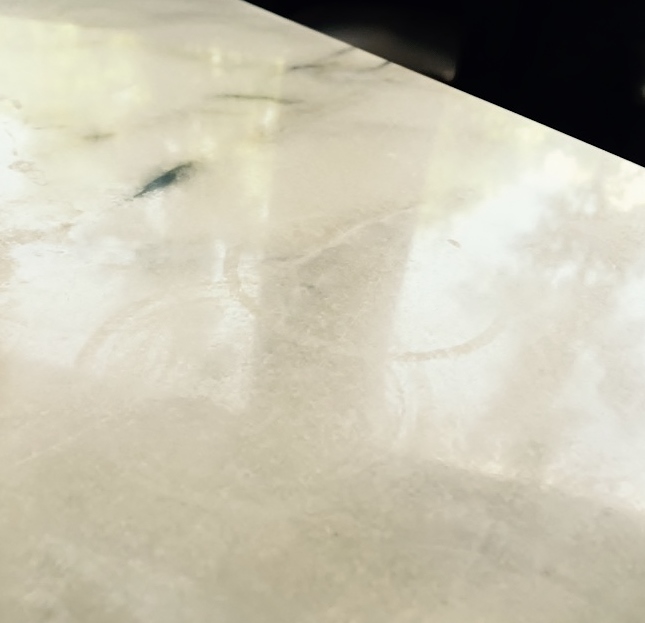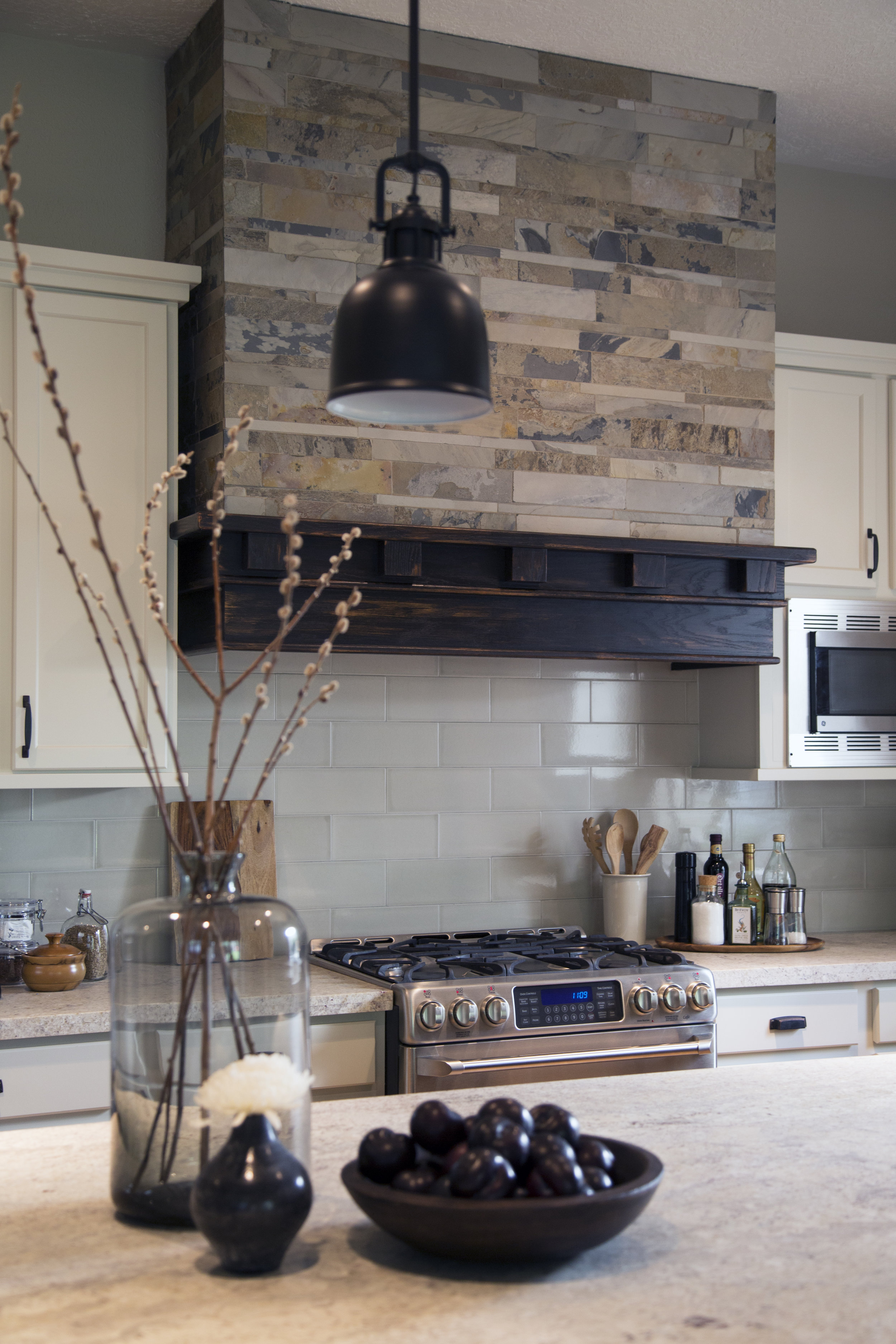I attended a really informative CEU last week and thought I’d share a few of the things we went over.
Now, I knew most of this, as I deal with kitchen countertops and materials every day. However, it helps to understand the geology and how that impacts the stone’s performance in the kitchen.
See the etched rings on this restaurant marble tabletop?
We all know that marble etches. The finish is marred and dulled whenever acid hits it for any length of time. We all know that granite doesn’t etch. Most of us know that quartzite has the soft look of marble, but has the properties of granite in that it doesn’t etch or stain.
We know that limestone is pretty soft and porous and can have some interesting fossils and shells embedded in the stone. We know that soapstone makes a great countertop except that it can show scratches and you apply mineral oil to the surface instead of sealer.
The main difference that we have to be aware of when specifying natural stone for countertops is what type of stone it is.
Here’s the big takeaway…
Calcareous stone reacts to chemicals (acid) and Siliceous stone does not.
That’s why granite, soapstone, slate, and quartzite will never etch from orange juice, wine, tomato sauce, etc. on your countertop. It’s just not one of their natural properties because they are siliceous.
And that’s exactly why marble, limestone, travertine, dolomite, and onyx will etch, because they are calcareous. They naturally do react to chemicals and there are not many sealers out there that can protect much against that.
Here’s a chart.
Here’s another fact. Calcareous stone has iron in it.
You know how Calacatta marble has some warm toned veining running through it? That’s an indication of the iron. And when the stone is wet for a long time, that iron might start to leach out and look like rust. I saw that recently on a job site at a shower curb. It really depends on the individual slab as far as how much iron is in the stone.
That’s how natural stones are, rather unpredictable. The makeup of the stone changes in the mountain naturally, so you don't have consistency.
Soapstone slab
Did you know that soapstone retains heat? That’s why it’s often used for fireplace surrounds up north. It’s a soft material but very dense. It might scratch since it’s soft, but applying mineral oil will fix that right up. Because it never reacts to chemicals like acid, it’s often used in laboratories as countertops. Soapstone is actually quite an ideal surface in the kitchen. I think I’d rather have mineral oil on my kitchen counters than a sealer.
Country / farmhouse kitchen with soapstone countertops - Carla Aston designer, Miro Dvorscak photographer
Here's a job where we combined white marble and soapstone on a job. We used marble on the island and backsplash and soapstone on the kitchen sink and range counters. The soapstone was a better surface for those two areas that received more use.
White marble on kitchen island and soapstone counter at perimeter cabinets - Carla Aston Designer
White marble countertop on kitchen island - Carla Aston Designer
Quartzite is becoming very popular as an alternative to marble. I’ve used it many times on projects. It consists of quartz, primarily. It’s been under more heat and pressure in the earth and is denser, therefore it holds up really well in the kitchen.
I know from my experience, that quartzite is more expensive and is tougher for fabricators to work with because it’s harder to cut. As a result, your countertops will cost more because of material and fabrication.
Macabus White quartzite countertops - Carla Aston Designer, Tori Aston Photographer
Taj Mahal quartzite countertops - Carla Aston Designer, Tori Aston Photographer
There was more covered in the class, but I think these are the most important takeaways. I know many people that design their own kitchens often don’t hear about the geology behind the different materials. And there is a lot of mixed information out there.
Our speaker referred often to the MIA, Marble Institute of America as the real source for information of natural stones.
I thought it was interesting that he said the names of natural stone as products for construction are sometimes not academically correct. For example, a material that might be categorized and called a granite, might really be classified academically as another type of stone, but because it has similar characteristics, is called a granite in the slab yard. That’s done for ease of identification in the industry.
A Few Natural Stone Myths Dispelled
One of the questions I asked was about marble in shower stalls.
I had an instance a few years ago where a vendor had told me to seal the back of the marble tile to keep the tile from absorbing any moisture that was behind. When marble tile is installed, the thinset behind it is obviously wet, and it is soaked with water during installation.
However, I learned that it is not a good idea to seal the back of a tile, that you want that moisture to evaporate and work it's way through the material. (Good, because I haven't ever advised that.)
Matter of fact, you can void the warranty on the tile. Apparently many times contractors will paint the back of glass tile, to keep the thinset from showing through, but that does void the warranty.
I also asked about finishes of natural stone countertops.
Years ago, when you couldn't find honed granite much, we wanted a matte surface for a granite countertop really badly. When you hone a granite, it typically softens the look of the grain and makes the slab lighter colored overall, which is exactly what I wanted.
Close up of honed granite countertop
We had the slab honed locally, it's basically a sanding process, to get the finish we wanted. However, I have been told by different vendors that honing a stone opens the pores, so to speak, and makes the stone more porous. Although I've been back to that job many times in the past years and the homeowner has had no problems with it whatsoever, I often wondered about that.
I had that myth dispelled thankfully, once and for all, and learned that is impossible. People tend to think of polishing as a sealant because it's shiny perhaps, but that is not correct. Polishing is done by even more finely sanding the surface, so that myth was busted. :-)
Honed granite countertops - Carla Aston Designer, Tori Aston Photographer
Honed granite countertops - Carla Aston Designer, Tori Aston Photographer
One last tidbit on natural stone countertop trends.
Granite - if it’s not black or white, it’s not selling these days. (I did an almost-black granite in a leather finish in my kitchen last year, one I've always loved and do more every day.) Check out my kitchen's before and afters right here.
My kitchen remodel - Carla Aston Designer, Tori Aston Photographer
I hope you are now armed with more information regarding natural stone for your home. If you like this article, please pin it or share it. :-)
Want more design tips for your upcoming projects?
Check out my Top 9 Telltale Signs Of A DIY Project. YOU don’t have to make them on your project.
















